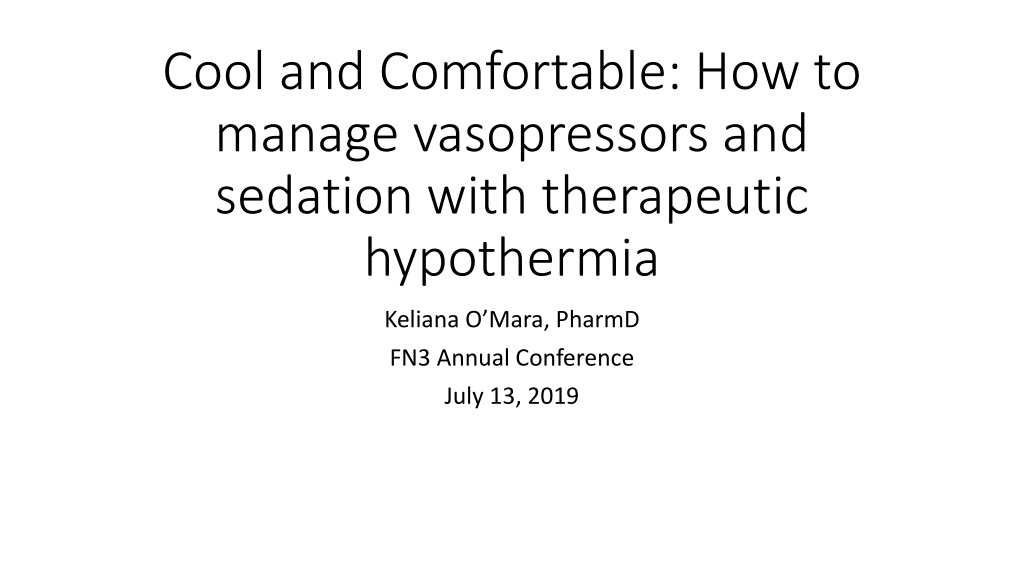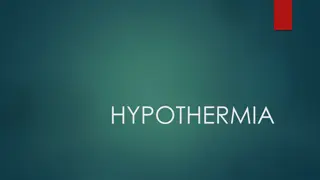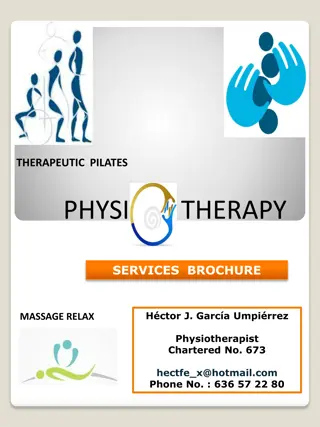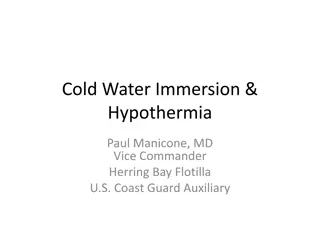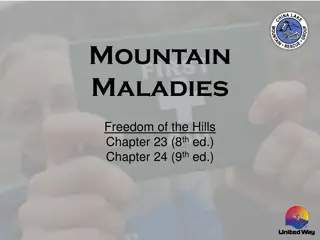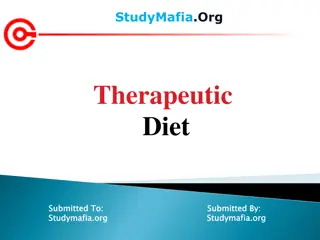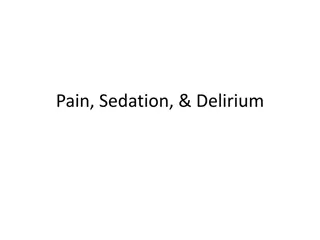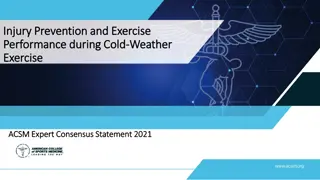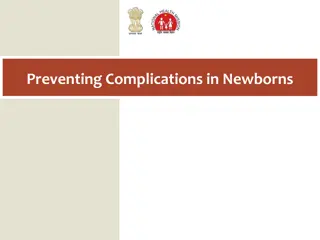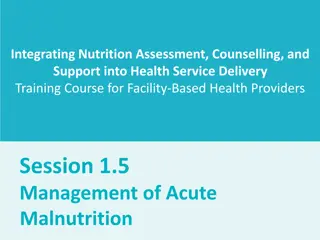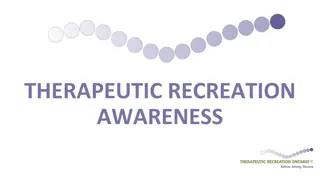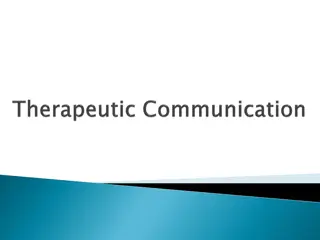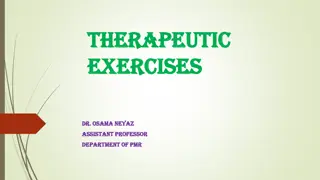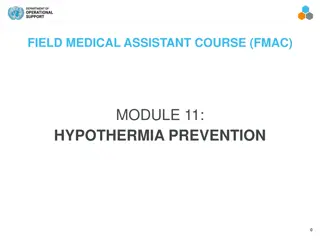Managing Vasopressors and Sedation in Therapeutic Hypothermia
This presentation discusses the pathophysiology of hypotension in neonates, the role of vasopressors and sedation in neonates with HIE, and the cardiovascular and pulmonary vascular effects of therapeutic hypothermia. It emphasizes the importance of a pathophysiology-based approach to managing vasopressors and sedation in neonates undergoing therapeutic hypothermia.
Download Presentation

Please find below an Image/Link to download the presentation.
The content on the website is provided AS IS for your information and personal use only. It may not be sold, licensed, or shared on other websites without obtaining consent from the author. Download presentation by click this link. If you encounter any issues during the download, it is possible that the publisher has removed the file from their server.
E N D
Presentation Transcript
Cool and Comfortable: How to manage vasopressors and sedation with therapeutic hypothermia Keliana O Mara, PharmD FN3 Annual Conference July 13, 2019
Objectives Review the pathophysiology of hypotension Discuss the role of vasopressors and ionotropes in neonates with hypotension Review sedation choices in neonates with HIE
Blood Pressure Component Role in Hypotension Vascular tone Vasodilation most common cause of shock Heart rate Neonates more dependent on HR to maintain BP (tachycardia, bradycardia) Contractility Systolic dysfunction most often seen with asphyxia Preload Insensible water losses, capillary leak, mechanical Afterload Elevated with pulmonary hypertension, worsens cardiac output
Cardiovascular Effects TH alone is not associated with increased risk of hypotension Normal or slightly increased BP related to hypothermia-induced vasoconstriction Reduction in heart rate after TH leads to 60-70% decrease in LV output compared to normothermic controls Often sufficient because of decreased metabolic activity Sinus bradycardia Slowed diastolic repolarization in SA node Diminished influence of sympathetic autonomous nervous system on heart rate Normal heart rate despite low temperature may reflect subclinical systemic hypoperfusion and contribute to ongoing brain injury
Pulmonary Vascular Effects Severity of brain injury may be associated with dysregulation of vascular tone in pulmonary vascular bed Concurrent HIE and pulmonary hypertension more likely to have abnormal brain MRI despite TH Greater disease severity-severe/prolonged hypoxia increases risk of impaired transition, persistent pulmonary hypertension
Pulmonary Vascular Effects on CNS Reduced pulmonary blood flow Lower preductal cardiac aoutput + systemic hypotension = worsened ischemic insult Use of rapidly-acting pulmonary vasodilators (iNO) Increased pulmonary venous return + augmentation of preductal cardiac output = reperfusion injury
Clinical Considerations/Confounders Variables Change Seen Pathophysiology Heart rate Sinus bradycardia Decreased SA node repolarization Increased DBP Systemic vasoconstriction Blood pressure Decreased SBP Decreased cardiac output Color Pallor Decreased skin perfusion Capillary refill time Prolongation Decreased skin perfusion Lactate washout after initiation insult, sequestering Lactate Lactic acidosis Blood gas Metabolic acidosis Residual perinatal acidosis Urinary output Oliguria or Anuria Acute renal injury
Effects of Rewarming Augmentation of cardiac output and systolic blood pressure + concurrent decrease in systemic vascular resistance and DBP Overall reduction in mean BP by ~8 mmHg Changes in drug volume of distribution, metabolism, and clearance High Vd medications mobilized from sequestered tissue and can have exaggerated effects during rewarming Adjustment of cardiovascular medications CNS hemorrhage during rewarming associated with greater degree of hemodynamic instability Avoid iatrogenic hypertension and excessive unregulated cerebral blood flow
Pharmacology of Hypotension Vasopressor Increases vascular tone Peripheral action: vasoconstriction via alpha-1 adrenergic and vasopressin receptors Inotrope: Increases myocardial contractility Example: dobutamine Vasopressor-inotrope Mixed effects, dose-dependent Examples: dopamine, epinephrine Phosphodiesterase inhibitors Example: milrinone
HIE: Hypovolemia Hypotension Aggressive volume resuscitation should be avoided Association between increased cerebral blood flow and poor outcome Exception: direct evidence of acute hypovolemia Blood transfusions for anemia + pulmonary hypertension Increased oxygen carrying capacity
Normal Saline Bolus Useful when hypovolemia is present Increased intravascular volume, increased CO 10 mL/kg NS = 1.54 mEq/kg of normal saline Limited efficacy when pathophysiology is not related to hypovolemia
HIE: Isolated Hypotension Presentation Low systolic BP and evidence of end organ hypoperfusion Treatment goals Increase stroke volume and cardiac output Treatment options Epinephrine Dobutamine
Dobutamine Indications: Hypotension/hypoperfusion related to myocardial dysfunction Severe sepsis/shock in full term neonates unresponsive to fluid resuscitation Dosing: 2 to 20 mcg/kg/min (max 25 mcg/kg/min) Monitoring: heart rate, BP Toxicity: hypotension, tachycardia, vasodilation
Epinephrine Dose-dependent stimulation of alpha and beta adrenergic receptors Low dose (0.01 to 0.1 mcg/kg/min) Stimulates cardiac and vascular beta 1 and 2 receptors Increased inotropy, chronotrophy, peripheral vasodilation Higher dose (>0.1 mcg/kg/min) Stimulates vascular and cardiac alpha 1 receptors Vasoconstriction, increased inotropy Net effect: increased blood pressure, systemic blood flow via drug-induced increases in SVR and cardiac output
Epinephrine Compared to dopamine Similar efficacy in improving blood pressure and increasing cerebral blood flow Epi group more likely to develop increased serum lactate levels, hyperglycemia requiring insulin Clinical considerations Beta-2 stimulation in liver and muscle causes decreased insulin release and increased glycogenolysis (elevates lactate) May be unable to use serum lactate as clinically useful marker of overall perfusion Insulin infusion may be necessary Most useful with low vascular resistance with or without myocardial contractility impairment
Epinephrine Dosing Information Low-dose : 0.01-0.1 mcg/kg/min High dose : >0.1 mcg/kg/min No documented true maximum dose Dose-limiting side effects: tachycardia, peripheral ischemia, lactic acidosis, hyperglycemia Titration: 0.01-0.02 mcg/kg/min every 3 to 5 minutes Monitoring: MAP, heart rate, glucose, lactates Administration: NEVER through arterial access, central venous access preferred
Hypotension + Increased Afterload Presentation Low pulmonary blood flow, impaired oxygenation, low cardiac output Treatment goals Sedation, +/- muscle relaxation, ventilation, iNO Avoid excessive mean airway pressure further impairment of pulmonary venous return Treatment options Dobutamine Milrinone Vasopressin Norepinephrine
Milrinone Selective phosphodiesterase-III inhibitor Exerts cardiovascular effects through preventing breakdown of cAMP Enhances myocardial contractility, promotes myocardial relaxation, decreases vascular tone in systemic and pulmonary vascular beds Disease states Post-operative cardiac repair, PPHN as an adjunct to iNO Post PDA-ligation to prevent hemodynamic instability in 24 hours after procedure
Milrinone-PPHN In cases unresponsive to iNO, oxygenation may be improved with addition of milrinone Exogenous NO upregulates PDE-III in smooth muscle cells of pulmonary vasculature Decrease or loss of cAMP-dependent vasodilation Addition of milrinone to iNO restores pulmonary vasodilation mechanisms dependent of cAMP Increased pulmonary vasodilation, improved oxygenation
Milrinone Dosing Information Dosing range: 0.25-0.99 mcg/kg/min Dose reduce for renal impairment Titration: 0.2-0.4 mcg/kg/min every 2-4 hours Monitoring: MAP: can initially decrease, usually returns to baseline within 1-2 hours Heart rate: can initially decrease, may increase if bolus used (not recommended) UOP: improved Oxygen saturations: improved
Vasopressin Primary physiologic role is extracellular osmolarity Vascular effects mediated by stimulation of vasopressin 1A and 2 receptors in the cardiovascular system V1A: vasoconstriction V2: vasodilation Most useful with vasodilatory shock, deficiency of endogenous vasopressin production with septic shock, infants after cardiac surgery
Vasopressin Clinical Considerations Increases MAP, SVR Decreases PVR, oxygenation index, iNO requirement, vasopressor requirement At high doses, increased SVR may impair cardiac contractility
Vasopressin Dosing Information Low dose : 0.17 -0.7 milli-units/kg/min Decreased in catecholamine requirement High dose : 1-20 milli-units/kg/min Effective for reducing catecholamine requirement, but more side effects Titration: 0.05-0.1 milli-units/kg/min every 15-30 minutes Monitoring: Blood pressure, serum sodium (hyponatremia), weight gain, urine output (decreases), liver enzymes
Norepinephrine Endogenous catecholamine that activates alpha 1,2 and beta 1 receptors Increases systemic vascular resistance>>pulmonary vascular resistance Increases cardiac output by increasing contractility via beta 1 receptors First-line treatment for septic shock in adult patients Neonatal data Sepsis: increased MAP, decreased oxygen requirement, improved tissue perfusion PPHN: produced pulmonary vasodilation, decreased oxygen requirement, increased cardiac output, improved blood flow to lungs without evidence of peripheral ischemia
Norepinephrine Dosing Information Dosing range: 0.05-0.7 mcg/kg/min Max: 3.3 mcg/kg/min Titration: 0.05-0.1 mcg/kg/min every 5-10 minutes Monitoring: MAP, oxygen saturations, tissue perfusion Administration: NEVER through arterial line, central venous access preferred
Refractory Hypotension Adrenal insufficiency can occur independently or in combination with other causes of hypotension Refractory Persistent hypotension despite catecholamine therapy Hypoglycemia, hyponatremia Adrenal injury Treatment Hydrocortisone
Hydrocortisone Decreases breakdown of catecholamines, increases calcium in myocardial cells, upregulate adrenergic receptors Delayed onset of action for hypotension Inferior as first-line treatment to dopamine Relative adrenal insufficiency in premature infants may play a role in need for supplementation Timing Prophylactic: prevents adrenal insufficiency, subsequent complications of uninhibited inflammation Refractory hypotension: effectively increases BP and reduces catecholamine requirement
What about Dopamine? Most commonly used cardiovascular medication in the NICU Dose-dependent stimulation of alpha, beta, and dopaminergic receptors Low (<0.5 mcg/kg/min) Vascular dopaminergic receptors selectively expressed Renal, mesenteric, coronary circulations Moderate (2-4 mcg/kg/min) Alpha receptor activation-vasoconstriction, inotropy High (> 4 8 mcg/kg/min) Beta receptor activation-inotropy, chronotropy, peripheral vasodilation Can increase pulmonary vascular resistance (worsen PPHN) Decreased contractility/excessive increase in SVR
Dopamine Dosing Information Usual dosing range: 5-20 mcg/kg/min Titration: 2.5-5 mcg/kg/min every 5-10 minutes Monitoring: MAPs, oxygen saturations, urine output Concerns: worsening pulmonary status when used in patients with pulmonary hypertension (i.e. PDA with right-to-left flow) Administration: NEVER through arterial line, central venous access preferred
Approach to Cardiovascular Care Consider pathophysiology, phase of intervention, and impact of concomitant treatments For HIE patients, weigh impact of treatment against consequences of reperfusion injury
Sedation Management in HIE Need for treatment Treatment options Monitoring/Assessment
Physiologic Response to Hypoxia-Ischemia Pre and postnatal asphyxia increase HPA axis stimulation Response correlates to gestational age and severity of hypoxia-ischemia Elevated cortisol/adrenal response may interfere with protective effect of hypothermia via activation of glucocorticoid pathways TH does not attenuate the HPA axis response to hypoxic-ischemic stress
Mild Hypothermia in Unsedated Newborn Pigs-Pediatric Res 2001 Known information 3 to 12 hours of mild TH started after HI is neuroprotective in anesthesized piglets Study purpose Determine if neuroprotection maintained in non-sedated piglets Study design 39 piglets (36=HI, 3=no HI) Normothermia = 18 Hypothermia x 24 hr = 21 + 3 no HI
Mild Hypothermia in Unsedated Newborn Pigs-Pediatric Res 2001
Mild Hypothermia in Unsedated Newborn Pigs-Pediatric Res 2001 Conclusions NO neuroprotection seen in piglets undergoing TH without sedation Only study in pigliets to directly evaluate TH in the absence of sedation Previous studies by same group used sedation and saw decreases in HR/MAP, demonstrated neuroprotection Theory: stress from being awake during HT negates the neuroprotective effect of TH
Stress Response to Therapeutic Hypothermia (TH) Induction of stress response in non-sedated patients In adult patients, lack of sedation during TH resulted in increased plasma levels of norepinephrine and cortisol, increased shivering Increased basal metabolic rate may limit protective effect of HT Non-sedated and conscious subjects being cooled with try to maintain temperature by increasing metabolic activity
Fentanyl vs. Morphine-J Peds 1999 Evaluated the effect of fentanyl and morphine on plasma catecholamines in neonates undergoing mechanical ventilation after birth Fentanyl: 10.5 mcg/kg bolus followed by 1.5 mcg/kg/hr continuous infusion Morphine: 140 mcg/kg bolus followed by 20 mcg/kg/hr continuous infusion
Fentanyl vs. Morphine-J Peds 1999 Fentanyl and morphine both effective for lowering noradrenaline and adrenaline levels in neonates undergoing mechanical ventilation Only fentanyl reduced beta endorphin Fentanyl and morphine displayed similar analgesic effects No notable respiratory depression in either group
Neonatal Response to Asphyxia Uncontrolled pain may potentiate the effect of hypoxia Exposure to untreated repetitive pain and stress causes prolonged C-fiber firing Glutamate-induced NMDA receptor activation Augmentation of hypoxia-induced glutamate release End result: neuronal injury/death
Opioid Effect on Neuroimaging Retrospective evaluation of 52 infants with some degree of birth asphyxia Received opioid = 17 No opioid = 35 Opioid: Morphine (intermittent bolus or infusion) Fentanyl (intermittent bolus or infusion) First week of life
Opioid Effect on Neuroimaging Opioid-treated infants were more critically ill, worse clinical markers of asphyxia at baseline Better MRI findings Improved long term neurologic examination findings at 12-8 months Potential for neuroprotection in hypoxic-ischemic brains Endogenous and exogenous opioids can protect cortical neurons from hypoxia-induced apoptosis Induce ischemic tolerance in cerebellar Purkinje cells subject to ischemia- reperfusion conditions
Sedation in Early Trials Study Intervention (N) Sedation Outcomes Azzopardi et al. Pediatrics 2000 Whole body hypothermia Pilot study (n=16, 10 TH, 6 NT) Morphine infusion 10-40 mcg/kg/hr (ventilated) 6/10 cooled infants had minor neurologic abnormalities or normal f/u exams Chloral hydrate 25- 50 mg/kg (non- ventilated) Thoresen, Whitelaw Pediatrics 2000 CV changes during mild TH (n=9) Midazolam 100 mcg/kg bolus then 30-60 mcg/kg/hr Marked reduction in spontaneous muscle activity, rectal temp Roka et al. Pediatrics 2008 Serum morphine concentration in HT and NT infants (n=16) Morphine infusion Elevated morphine concentrations in HT compared to NT patients
